 Last year, I wrote a post about the new English Standard Version Catholic Edition Bible (ESV-CE) published in India. This year, I have the great pleasure of announcing that this new translation is now available for purchase in the United States, thanks to the Augustine Institute! Yes, it is finally here.
Last year, I wrote a post about the new English Standard Version Catholic Edition Bible (ESV-CE) published in India. This year, I have the great pleasure of announcing that this new translation is now available for purchase in the United States, thanks to the Augustine Institute! Yes, it is finally here.
You can buy the ESV-CE Bible here: https://catholic.store/the-augustine-bible/
The Protestant Backstory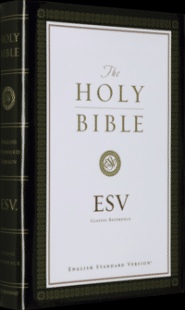
The ESV translation first came out in 2001 from Crossway publishers as a Protestant Bible for the Protestant market. The translation was partially born from a late-1990’s controversy over the inclusive language edition of the New International Version Bible–the NIVI. Many Bible readers were unhappy with the translation choices of the NRSV and NIVI. A new translation was needed. Instead of revising one of those translations, Crossway chose to go back to the RSV and then work from there.
What about the RSV?
The Revised Standard Vervsion (the Standard Version is the King James) originally came out in 1950’s and was revised in the 1970’s and then replaced by the NRSV. Many Catholic have used the RSV Bible in two versions–the original RSV-Catholic Edition and the so-called RSV-2CE from Ignatius Press, which was developed in partnership with the Congregation for Divine Worship under the guidelines of Liturgiam authenticam. The RSV-2CE is the translation in the Catholic Bible Study App offered by a partnership of Ignatius and the Augustine Institute.
What is different about the ESV?
The ESV is then a revision of the RSV. The ESV has modified about 60,000 words from the RSV. So it is a “daughter translation,” if you will, not a completely new from-scratch translation, but this makes the ESV feel like an old friend and a new teacher at the same time. It sounds strangely familiar and yet new. It offloads the archaic terms like the “thees, thous and wherefores.” It relies on better analyses of the manuscript tradition. The King James was based on the old Textus receptus of Erasmus, while the ESV is based on the newest critical editions available. It actually restores some King James readings that are more accurate than the RSV: “For example, Isaiah 7:14 was changed back to say, ‘Behold, the virgin shall conceive and bear a son.’ Psalm 2:12 once again says, ‘Kiss the Son,’ and Psalm 45:6 is once again a Messianic prediction that says, ‘Your throne, O God, is forever and ever'” (Source: Wayne Grudem, “The Advantages of the English Standard Version (ESV) Translation” p. 3).
How did a Protestant Translation become Catholic?
The Bishops Conference of India needed a new English translation for the Lectionary and other liturgical purposes. Crossway worked out a deal with them, where a team of Catholic theologians and Scripture scholars headed up by Fr. Lucien Legrand, M.E.P. (now 93 years old!), would review the ESV translation carefully and make some emendations. The Catholic team did indeed review–and change–the text of the ESV in preparation for publication. The biggest change was the Book of Tobit, which had to be retranslated from scratch. The translation was reviewed in accord with the norms of Liturgiam authenticam, then it was approved and granted the Impimatur by the whole Conference of Catholic Bishops of India and published in early 2018. It is available in India from the Asian Trading Corporation.
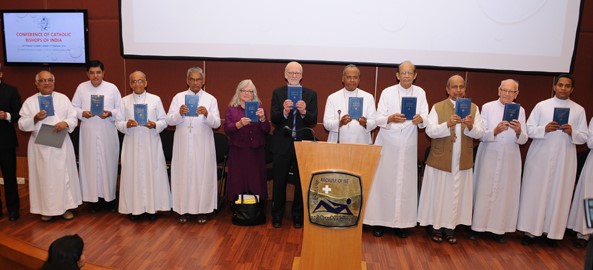
Indian Bishops with ESV (photo from daijiworld.com). Notice the founders of Crossway in the middle: Lane and Ebeth Dennis.
Speaking of Tobit, what about the deuterocanon?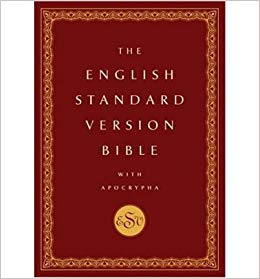
The original 2001 ESV did not include the deuterocanonical books (the ones in Catholic, but not Protestant Bibles), but in 2010, ESV did a joint publication with Oxford University Press which did include the deuterocanon. This edition, entitled “The English Standard Version Bible with Apocrypha,” was only published once as far as I can tell, but it served as the basis for the ESV Catholic Edition rendering of the deuterocanonical books, except Tobit, as I mentioned above.
Augustine Institute?
The Augustine Institute, where I teach as a professor of Sacred Scripture, though originally only a graduate school, has become something of a media and publication apostolate with our Formed.org video platform and our merger with Lighthouse Catholic Media. We struck up a conversation with Crossway about the ESV Catholic Edition a couple years ago. It became clear that Crossway, as a Protestant publisher, did not feel well-suited to serve the Catholic market and wanted a Catholic partner to promote the new translation. Earlier this year (2019), we reached an agreement and hurried to put out our first-ever Bible publication before the end of the year. (Well, our second if you count the “Bible in a Year” RSV-2CE to which I contributed.) We’ve dubbed it the “Augustine Bible” in honor of our patron.
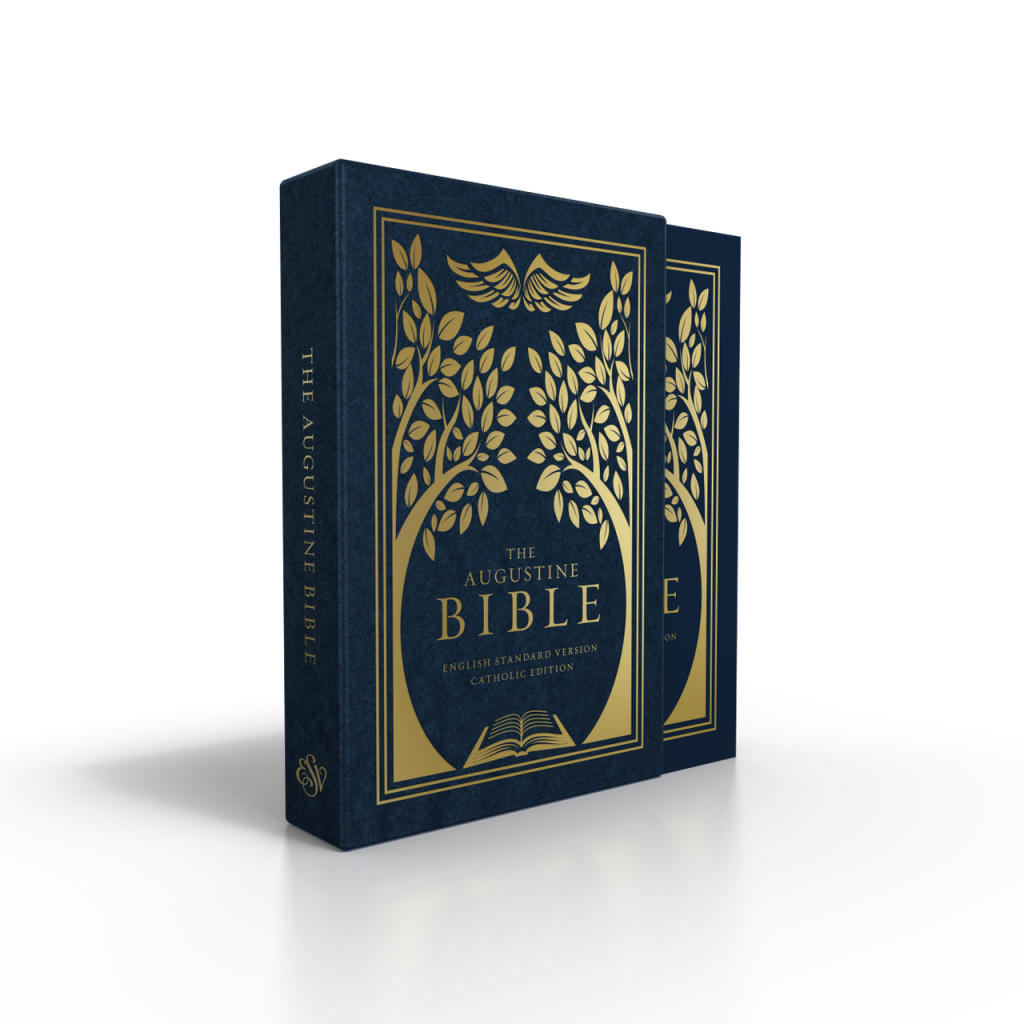 A New Beginning
A New Beginning
The first ESV Catholic Edition Bible available in the United States is now ready for order. It arrived in the Augustine Institute warehouse just a few days ago. This edition is really only the firstfruits of a huge new opportunity for Catholic Bible readers. Hopefully, the Augustine Institute will be releasing many different editions of this great translation over the coming years. I have enjoyed using the ESV for study and teaching for years and I hope that you enjoy the new ESV Catholic Edition as much as I have. So go ahead and order one and see what you think.
Here’s the link again: https://catholic.store/the-augustine-bible/

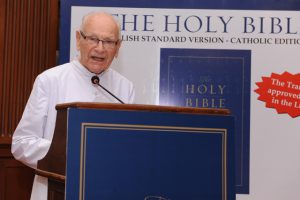
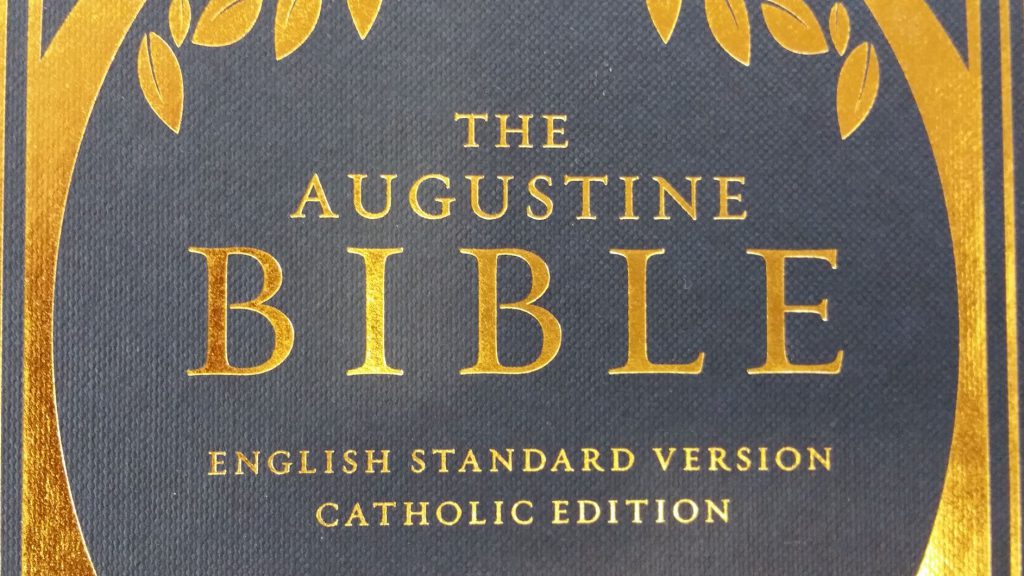
The Augustine Institute has to eventually release a premium leather edition of this Bible.
Dr Giszczak: Are there page spreads, reading samples, or even just pictures of the inside of this new edition available anywhere? I’m an Orthodox priest who uses RSV-2CE for adult formation and speaking engagements, but have experience with the ESV and am genuinely interested in the Augustine Bible. It seems odd, however, to launch an edition like this without any supporting materials allowing an inside look, so I thought I’d ask, since I seem to be missing them entirely. Many thanks, and congratulations on this new publication!
I’m excited by this news, and especially hope to see some Catholic premium Bibles to follow, like Crossway’s own goatskin ones, or RL Allan, or Cambridge.
Is the text identical with the Indian ESV-CE?
Was it ever determined in what ways (other than the deuterocanonical books) the ESV-CE differs from the ESV?
What textual variant of the ESV was used as the basis? 2016? 2011?
@ThomasL: Yes, more editions to follow. Yes, it is identical to the Indian ESV-CE. Yes, the differences are identified–more to follow on this in my blog and elsewhere. The most recent ESV text was used as the basis, so 2016.
@Fr. Esteban: Not yet. I hope that we will get these digital previews out there soon.
This is should be good new for conservative Roman Catholics.
The Ignatius Bible: RSV, 2nd CE was the only modern english Roman Catholic Bible in print that was not tainted by liberalism (like in the NJB) or the severely neutered NABRE Bible with all the inclusive language nonsense. The ESV-CE can be added that list of modern Bibles being on par with The Ignatius Bible: RSV, 2nd CE.
As a confessional Lutheran I could never understand why RCC would approve the NABRE and the NJB for for liturgical use and for serious Bible study.
You mentioned the Book of Tobit was retranslated from scratch. Do you have more details on why they chose or had to retranslate Tobit? Perhaps, it had something to do with Liturgiam authenticam? 🤷🏻♂️
I own the The Ignatius Bible: RSV, 2nd CE and the ESV, Apocrypha (Lutherans addition). When I read through the two versions, I don’t see any significant differences, between the two versions. From my layman’s perspective the ESV Apocrypha (Lutherans addition), and the RSV, 2nd CE, render the Book of Tobit almost the same, other than some minor difference.
Tobit 1:1–2 (Ignatius: RSV 2nd, CE) “1 The book of the acts of Tobit the son of Tobiel, son of Ananiel, son of Aduel, son of Gabael, of the descendants of Asi-el and the tribe of Naphtali, 2 who in the days of Shalmaneser *, king of the Assyrians, was taken into captivity from Thisbe, which is to the south of Kedesh Naphtali in Galilee above Asher. ”
*Foot notes: Gk Enemessarus.
https://ref.ly/Tob1.1-2;rsv2ce via @Logos
Tobit 1: 1-2 (ESV, Lutheran) “1 The book of the acts of Tobit son of Tobiel, son of Ananiel, son of Aduel, son of Gabael, of the descendants of Asiel and the tribe of Naphtali, 2 who in the days of King Enemessarus * of the Assyrians was taken into captivity from Thisbe, which is to the south of Kedesh Naphtali in Galilee above Asher. ”
* Foot notes: Syriac Shalmaneser; also verses 13, 15, 16
https://ref.ly/Tob1;apcrphlthd via @Logos
Tobit 1:16 (Ignatius: RSV 2nd, CE) “In the days of Shalmaneser * I performed many acts of charity to my brethren.”
* The foot notes: Shalmaneser =Gk Enemessarus.
Tobit 1:16 (ESV, Lutheran) “In the days of Enemessarus I performed many acts of charity to my kindred. ”
I ordered the The Augustine Bible (ESV-CE) I’m curious to see how the book of Tobit reads in comparison to the Ignatius Bible: RSV, 2nd CE and ESV, Apocrypha (Lutheran addition).
All they need next is The Augustine Bible (ESV-CE) Logos addition.
As a non-Roman Catholic I enjoyed reading through your blog. Grace and Peace be with you.
@Fr. Esteban: I have just posted a series of photos of the inside of the new ESV Catholic Edition Bible: https://catholicbiblestudent.com/2019/12/esv-catholic-edition-bible-first-look-photos.html
Many thanks for this update, Dr Giszczak! I’ve just had a look at the pictures, and look forward to viewing a copy sometime in the near future.
I am glad the ESV-CE has come to the USA. I am hoping that they will publish it in a single column format similar to the ESV reader’s bible ( here: https://smile.amazon.com/Readers-Bible-Cloth-Permanent-Slipcase/dp/1433553473/ref=sr_1_1?crid=3OKFZH9Y08HKX&keywords=esv+readers+bible&qid=1577640501&sprefix=ESV+readers%2Caps%2C163&sr=8-1 ) or the Tyndale Select NLT (single column in 1 volume). They could produce it in an ESV-CE 3 volume set – OT, Deuterocanonicals & NT Reader’s version and a study version.
Does this Bible include books like 1 & 2 Esdras, 3 & 4 Maccabees, and the Prayer of Manasseh (as in the original ESV/Apocrypha), or does it stick strictly to the Roman Catholic canon/deuterocanon?
Can you tell us the reading at Genesis 3:16 and Genesis 4:7? Did they keep the ESV-2016 reading of “contrary to” or did they go back to the traditional reading of “for” (ESV-2011)?
The ESV Catholic Edition includes only the canon recognized by the Catholic Church, so it does not include 3 & 4 Maccabees, etc.
@Kiyah: They kept the controversial ESV-2016 “contrary to” reading at those verses.
This is interesting news, the ESV is a nice translation and one I used as a Protestant (now Orthodox). Do the psalms use the LXX numbering or Hebrew numbering?
Obviously not the scope of this project but it’d be nice to see an ESV Common Bible that is a successor to the RSV Common Bible which included the additional books recognized Orthodox Churches.
Glad to see this happening!
What edition of the ESV is used in the Augustine Bible? 2016, 2011, 2007?
@Fernando: The Augustine Bible uses the ESV Catholic Edition (ESV-CE for short), which is an update and expansion of the ESV-2016. It includes the deuterocanon and makes a few changes to the ESV-2016 text.
@Steven: The ESV Catholic Edition uses the typical Hebrew numbering for the Psalms. I agree that it would be nice to see a new Common Bible based on the ESV. I don’t know of any plans in this direction.
Thank you for writing informative blogs like this and the other ones related to the ESV-CE! As a Southern Baptist pastor, I use the ESV as my primary Bible for studying, preaching, and teaching. I also read the well-made CSB, which strikes a good balance between the ESV and the NIV/NLT but avoiding the over-gender neutralization of the NIV 2011 and NRSV.
I also like reading the RSV-2CE on my Didache Bible as it is really close to the ESV text. I also have the RSV-CE but prefer the RSV-2CE because the latter did away with the archaic words such as “these” and “thous” that were retained by the former.
Any hope of finding this on biblegateway dot com?
@Scott: At this point, I don’t know. But since the ESV (Protestant edition) is up there, I don’t see any major roadblocks.